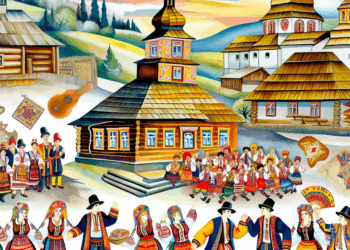Bukovina is a historical region that changed its borders and political affiliation many times during the 20th century. Known for its multi-ethnic composition, it has attracted the attention of various states over the centuries, including the Austrian Empire, Romania and the USSR. This article examines the key events and territorial changes that have occurred in the region since 1775.
1. Period of the Austrian Empire (1775-1918)
The history of Bukovina as an administrative unit began in 1775, when it was annexed by the Austrian Empire. This happened as a result of the War of the Austrian Succession, when the Austrian authorities managed to conclude a peace treaty that brought the territory under their control from the Ottoman Empire. At the time, Bukovina was inhabited predominantly by Ukrainians, Romanians and Jews, which led to a diversity of cultures and traditions in the region.
Under Austrian rule, Bukovina became an important administrative and cultural centre. In 1849, an autonomous ducal district was founded, which significantly increased the importance of the region in the political arena. Educational and infrastructural development was particularly active at this time: many towns, such as Chernivtsi, received new buildings and also gained access to modern transport systems. In 1910, the region was home to around 800,000 people.
2 Annexation by Romania (1918-1940)
After the end of World War I and the collapse of the Austro-Hungarian Empire, Bukovina became part of Romania in 1918. The Romanian government introduced a series of reforms aimed at integrating the region into the national system. Romanian became the main language of instruction in schools, which, however, met with resistance among the local population, where Ukrainians and Jews made up a significant proportion.
During this period, a famous university library and other cultural institutions were built in Chernivtsi, the new capital of Bukovina, which promoted education and science. However, the choice of Romania as the new national entity was not painless, and reflected the complex inter-ethnic relations and conflicts that were growing in the region.
With the outbreak of World War II, in 1940, the international situation in Eastern Europe changed dramatically. Romania, losing its territories, concluded a non-aggression pact with the Soviet Union, which was the beginning of a new transformation for Bukovina.
3. Soviet annexation (1940-1941 and 1944-1991)
As a result of the secret protocol to the Molotov-Ribbentrop Pact, in June 1940, part of Bukovina was annexed by the Soviet Union, which announced the creation of Transnistria – a temporary state entity that included Bukovina. However, the occupation was short-lived; already in 1941, during Operation Barbarossa, the territory was occupied by Nazi Germany.
After the end of World War II in 1944, the Soviet Union regained control over Bukovina. This period was a time when new borders were formed, when the Ukrainian population increased significantly due to resettlement, as well as repressions and population changes.
In 1946, the Chernivtsi Oblast was reestablished as part of the Ukrainian SSR, and the region’s population began to actively participate in Soviet cultural and political life. Sovietisation of products and culture, high rates of industrialisation led to changes in the lifestyle of local residents.
4. Modern borders and public opinion
With the collapse of the Soviet Union in 1991 and the independence of Ukraine, Bukovyna became part of the newly independent country. The borders of the region were confirmed by the newly independent Ukraine, and most historical and cultural ties with Romania remained outside official policy.
Despite the official representation, Bukovyna is, as before, an area with a complex ethno-geographical structure. The public opinion of local residents, especially the Romanian and Ukrainian populations, is diverse and includes both a desire to preserve local traditions and a broader understanding of the importance of integration into the European community.
Conclusion
Throughout the 20th century, Bukovina experienced many changes and territorial annexations, becoming an arena of multi-ethnic conflicts and cultural transformations. Today’s Bukovyna includes part of the Chernivtsi Oblast of Ukraine, while preserving the rich diversity of culture and historical heritage that forms its multi-cultural Romanian, Ukrainian and Jewish roots.
The diversity of opinions and ideas about national identity is still relevant and of interest to historians, cultural historians and the general public. Despite the changes in political borders, Bukovina, as before, remains an important historical and cultural centre where the roads of different peoples and traditions cross.








